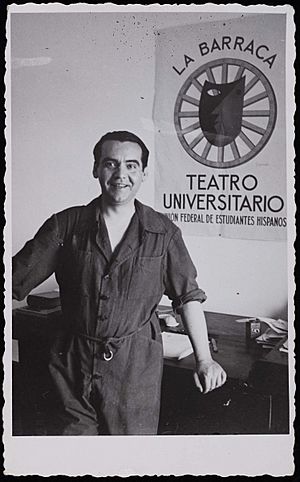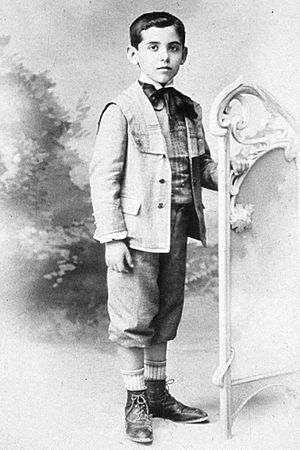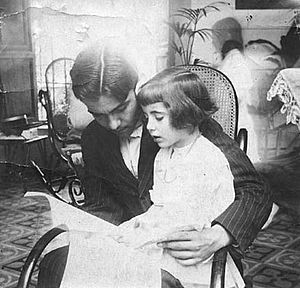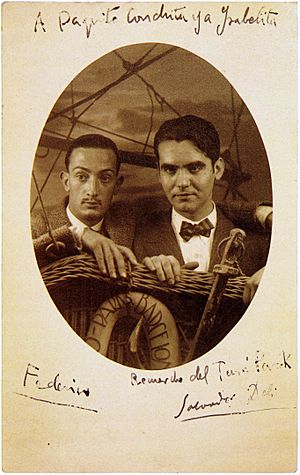Federico García Lorca facts for kids
Quick facts for kids
Federico García Lorca
|
|
|---|---|

García Lorca in 1932
|
|
| Born |
Federico del Sagrado Corazón de Jesús García Lorca
5 June 1898 |
| Died | 19 August 1936 (aged 38) Near Alfacar, Granada, Spain
|
| Nationality | Spanish |
| Education | Columbia University University of Granada |
| Occupation |
|
| Movement | Generation of '27 |
| Parent(s) | Federico García Rodríguez Vicenta Lorca Romero |
| Signature | |
 |
|
Federico del Sagrado Corazón de Jesús García Lorca (born June 5, 1898 – died August 19, 1936), known as Federico García Lorca, was a famous Spanish poet, writer of plays, and theatre director.
He first became well-known for his poetry book Romancero gitano (Gypsy Ballads), published in 1928. This book showed life in his home region of Andalusia, Spain. Some of his most famous plays include Blood Wedding (1932), Yerma (1934), and The House of Bernarda Alba (1936).
Contents
Life and His Creative Journey
Growing Up in Spain
Federico García Lorca was born on June 5, 1898. His birthplace was Fuente Vaqueros, a small town near Granada in southern Spain. His father, Federico García Rodríguez, was a successful landowner. His mother, Vicenta Lorca Romero, worked as a teacher.
In 1915, after finishing high school, García Lorca went to the University of Granada. There, he studied law, literature, and music composition. When he was younger, he loved music even more than writing. At age 11, he started piano lessons with Antonio Segura Mesa. Segura was a music teacher and composer who inspired Federico to dream of a music career.
García Lorca only started writing after Segura died in 1916. His first writings, like "Nocturne" and "Ballade," were inspired by musical forms.
Becoming a Writer
While at the Residencia de Estudiantes in Madrid, García Lorca met many creative artists. These included Luis Buñuel and Salvador Dalí. They would all become very important in Spain's art world.
His first book of poems, Libro de poemas, came out in 1921. Over the next few years, García Lorca became a key part of Spain's modern art movement. His poems and drawings often showed traditional Andalusian styles.
His book Romancero gitano (Gypsy Ballads, 1928) became his most famous poetry collection. This book made him well-known across Spain and the Spanish-speaking world. He became famous as a playwright much later. Throughout his life, he tried to capture the true spirit of Andalusian culture in his work.
In June 1929, García Lorca traveled to the United States on the RMS Olympic. This ship was a sister to the famous RMS Titanic. In New York, he tried to learn English. However, he spent more time writing than studying. His collection Poeta en Nueva York (Poet in New York) was published after he died in 1940. This book was very different from his earlier work.
García Lorca returned to Spain in 1930. This was when the dictatorship of Primo de Rivera ended. The Second Spanish Republic was then formed. In 1931, García Lorca became the director of a student theatre group called Teatro Universitario La Barraca (The Shack).
This group was funded by the government. Their job was to travel to rural areas of Spain. They performed classic Spanish plays for free for people who had never seen theatre before. García Lorca directed the plays and sometimes acted in them.

Besides theatre, García Lorca also used traditional styles in his poetry. He spent his summers at the Huerta de San Vicente from 1926 to 1936. Here, he wrote some of his most important works. These include When Five Years Pass (1931), Blood Wedding (1932), Yerma (1934), and Diván del Tamarit (1931–1936). He was living at the Huerta de San Vicente just before he was arrested and killed in August 1936.
García Lorca was also a talented artist, though his drawings are not as well-known as his writing.
His Tragic Death
García Lorca was killed by forces against the government at the start of the Spanish Civil War. His body has never been found. The exact reason for his death is still debated. Some believe he was targeted for his political views or personal life. Others think it was due to a personal disagreement.
Remembering Federico García Lorca
Many places honor Federico García Lorca. In Granada, his hometown, the Parque Federico García Lorca is dedicated to him. This park includes the Huerta de San Vicente, which was his family's summer home. It opened as a museum in 1995. The park has preserved the land, houses, art, and furniture.
There is a statue of Lorca on the Avenida de la Constitución in Granada's city center. A cultural center named after him is also being built. This center will help share his works with more people.
Another Parque Federico García Lorca is in Alfacar, near Fuente Grande. In 2009, searches there did not find Lorca's body. Near an olive tree, which some believe marks his grave, there is a stone memorial. It honors Federico García Lorca and all others who died in the Civil War from 1936 to 1939.
At the Barranco de Viznar, there is another memorial stone. It says, "Lorca eran todos, 18-8-2002" ("All were Lorca ..."). This area is known for mass graves and might be where the poet's remains are located.

In Madrid, a statue of García Lorca stands in the Plaza de Santa Ana. In Paris, France, there is a garden named after him in the city center, by the Seine river.
The Fundación Federico García Lorca is led by Lorca's niece, Laura García Lorca. This foundation helps celebrate and share his writings. They are building the Centro Federico García Lorca in Madrid. The Lorca family has given all of Federico's documents to this foundation for safekeeping.
Major Works
Poetry Collections
- Impresiones y paisajes (Impressions and Landscapes 1918)
- Libro de poemas (Book of Poems 1921)
- Poema del cante jondo (Poem of the Deep Song; written 1921, published 1931)
- Canciones (Songs written 1921–1924, published 1927)
- Romancero gitano (Gypsy Ballads 1928)
- Poeta en Nueva York (written 1930 – published 1940)
- Llanto por Ignacio Sánchez Mejías (Lament for Ignacio Sánchez Mejías 1935)
- Seis poemas galegos (Six Galician poems 1935)
- Sonetos del amor oscuro (Sonnets of Dark Love 1936, published 1983)
- Primeras canciones (First Songs 1936)
- Diván del Tamarit (The Tamarit Divan, poems written 1931–1934, published 1940)
Plays
- The Butterfly's Evil Spell: (written 1919–1920, first performed 1920)
- Mariana Pineda (written 1923–1925, first performed 1927)
- The Shoemaker's Prodigious Wife: (written 1926–1930, first performed 1930)
- The Love of Don Perlimplín and Belisa in the Garden: (written 1928, first performed 1933)
- When Five Years Pass: (written 1931, first performed 1945)
- Blood Wedding: (written 1932, first performed 1933)
- Yerma (written 1934, first performed 1934)
- Doña Rosita the Spinster: (written 1935, first performed 1935)
- The House of Bernarda Alba: (written 1936, first performed 1945)
Short Plays
- El paseo de Buster Keaton (Buster Keaton goes for a stroll 1928)
Film Scripts
- Viaje a la luna (Trip to the Moon 1929)
Drawings and Paintings
- Salvador Dalí, 1925. Ink and colored pencil on paper.
- Bust of a Dead Man, 1932. Ink and colored pencil on paper.
See also
 In Spanish: Federico García Lorca para niños
In Spanish: Federico García Lorca para niños





